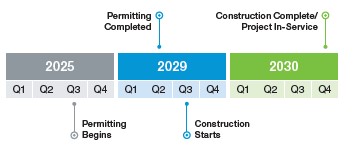Who is Horizon West Transmission?
Horizon West Transmission, LLC (Horizon West), is a subsidiary of NextEra Energy Transmission, a leading competitive transmission company that develops, finances, constructs, operates and maintains transmission assets across North America.
NextEra Energy Transmission subsidiaries own and operate high-voltage transmission assets in 10 states and Canada. The company’s investments are critical to improving the efficiency and reliability of the electric grid.
What is the Ironwood Transmission Line project?
The proposed Ironwood Transmission Line project is an approximately 87-mile, 500-kV transmission line that would primarily span southern Imperial County, California, connecting the existing North Gila substation in Yuma County, Arizona, and the Imperial Valley substation in Imperial County.
The critical east-west corridor would serve southern California’s and southwestern Arizona’s population centers, unlocking access to vast resources in Arizona and California’s Imperial Valley region.
What is the purpose of the Ironwood transmission line?
In May 2023, CAISO identified a portfolio of transmission projects in its 2022-2023 Transmission Plan that are needed to meet growing energy demand.
CAISO is the non-profit, independent system operator responsible for maintaining the reliability of the electric grid, planning for new transmission lines and operating the wholesale energy market in California and a small portion of Nevada. A new approximately 87-mile, 500-kV transmission line was included in the CAISO’s 2022-2023 Transmission Plan.
Overall, the proposed transmission line will help maintain the reliability of the electric grid and help meet state energy goals by providing access to multiple energy resources.
What is your role in this project?
The CAISO selected Horizon West Transmission as the project sponsor for the Ironwood transmission line.
Horizon West is now developing a detailed environmental assessment to evaluate proposed routes, which will be shaped by input from stakeholders, environmental groups, local governments, Tribal Nations and other interested parties.
Who will receive the power?
The Ironwood power line will help provide critical reinforcement of the electric grid in southern California and southwestern Arizona and provide over 3,000 megawatts of transfer capacity, enabling the delivery of energy to population centers in the region.
How will local communities benefit from the Ironwood project?
The project is expected to provide numerous benefits to the local community, including:
- Providing increased access to low-cost, reliable energy to California and Arizona
- Improving the reliability of the regional electric grid
- Spurring investment in local economies during construction
- Limiting impacts to local landowners by using existing transmission corridors and federal land where possible
- Enabling further development of Imperial County’s resources industry
- Providing state and local tax revenues of more than $128 million over the life of the Ironwood project that can be used to help fund schools, parks and roads
Where will the project be located?
The proposed transmission line will be located in southern California and southwestern Arizona.
A detailed environmental assessment is being conducted to evaluate proposed routes, which will be shaped by input from stakeholders, environmental groups, local governments, Tribal Nations and other interested parties.
After an independent analysis and public input, the California Public Utilities Commission, Arizona Corporation Commission and federal siting authorities will issue the final determination on the transmission line route.
What is the expected schedule?
The Ironwood Transmission Line is anticipated to be in service by 2030. The project schedule is subject to change based on regulatory approvals.
